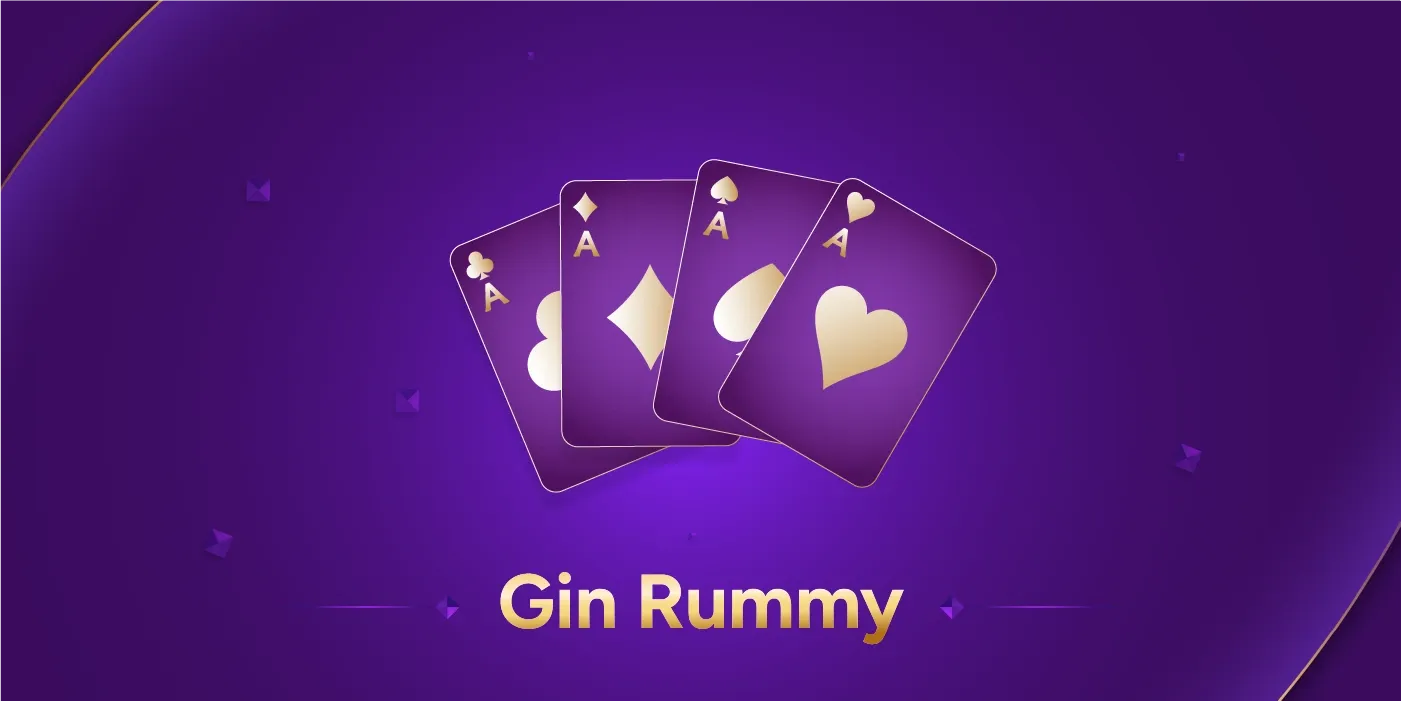- Home
- Did you know
- Gin rummy card game
Gin rummy card game
New to card games or rummy? Don't worry! Gin rummy is really simple once you get the hang of it, and you can start playing in just a few minutes!
Rummyprime Elite Editors | 17th Jul, 2025

Gin Rummy Card Game
Want to learn Gin rummy? You have landed in the right place.
Gin rummy, it is a classic 2-player game that is easy to learn.
Whether you play the game offline with friends or play online, this guide will help you understand the basics of Gin rummy, its objective, the rules of the game, scoring, gameplay and the variations.
New to card games or rummy? Don’t worry! Gin rummy is really simple once you get the hang of it, and you can start playing in just a few minutes!
Let’s dive in.
What is Gin rummy?
Gin rummy is a 2-player card game. 10 cards are dealt to each player by the dealer. The goal is to form valid sets and runs (sequences) using these 10 cards and to reduce the point value of unmatched cards. Players take turns drawing and discarding cards until one player either knocks or goes Gin.
Gin rummy is a fast-paced variant of traditional rummy that emphasizes creating combinations (melds) quickly, rather than just discarding cards.
History of Gin rummy
Gin rummy was created in the early 1900s, most likely as a variation of the older game “Whisky Poker” or “Conquian,” which is believed to have Mexican roots.
Charles Graham Baker and his father, Elwood Baker, an American card game expert, are widely credited with developing the game.
It gained traction in the 1930s and 1940s, particularly in Hollywood. Movie stars, screenwriters, and directors were known to play Gin rummy in between takes, making it Tinseltown’s unofficial card game.
Objective of Gin rummy
In Gin rummy, your goal is to form as many melds as possible-these include runs (sequences of three or more cards in the same suit) and sets (groups of three or four cards of the same rank)-while reducing the point value of any deadwood cards left in your hand.
A round can be ended by:
Going “Gin” (all cards are melded), or
Knocking (when your deadwood is 10 points or less).
The winner is the first to accumulate 100 points across multiple rounds
Note: In Gin rummy, the Ace is always low (A♠ 2♠ 3♠ is valid; Q♠ K♠ A♠ is not).
Deck in Gin rummy
In Gin rummy players use a standard 52 card deck. The cards ranked from highest to lowest: King, Queen, Jack, 10, 9,8,7,6,5,4,3, 2, and Ace as the lowest. The game focuses entirely on strategy using the traditional deck without the inclusion of jokers.
No jokers here! Just the regular 52 cards. Easy, right?
Deal: Gin rummy
To kick off Gin rummy, shuffle the deck and have both players draw a card; the one with the higher card becomes the dealer (for example, a King beats a 7).
The dealer then deals 10 cards to each player, one at a time, beginning with their opponent. After that, the rest of the deck is placed face down as the stock pile, and the dealer flips the top card to begin the discard pile.
The previous winner takes on the position of dealer for each new round, exchanging roles to guarantee the game is fair.
Gin rummy rules overview
Get familiar with the key rules and setup for Gin rummy, a timeless two-player card game.
Game preparation:
Number of Players: 2
Deck Used: 52 standard playing cards
Card Scoring: Number cards count as their printed value, face cards are 10 points each, and Aces are 1 point.
Dealing: Randomly select a dealer, who gives 10 cards to each participant.
Stockpile and Discard: The rest of the deck forms the stockpile, with the top card placed face up to start the discard pile.
How to play Gin rummy
- Each turn begins by drawing one card from either the stockpile or the discard pile.
- Players try to form sets or runs with their cards.
- After drawing and optionally forming melds, the player discards one card to end their turn.
- A player may knock to end the round if their deadwood (unmatched cards) totals 10 points or less.
- If a player uses all 10 cards in valid melds (no deadwood), they declare “Gin” and end the round.
Gin rummy gameplay
Once the cards are dealt and the discard pile is set up, the round begins.
Player B (the player who is not dealing) takes the first turn.
Initial Move:
Player B gets to make the initial selection. Imagine the visible card in the discard pile is the 7♦ (7 of Diamonds).
Option 1: If Player B needs the 7♦, they take it and then discard another card from their hand. Suppose they discard a 3♠ (3 of Spades).
Option 2: If Player B doesn’t want to take the 7♦, they will say “pass.” It is now the turn of Player A (the dealer).
Player A can take the 7♦ or pass as well. If both players choose to pass, Player B is required to draw a card from the stock pile that is face down. From that moment on, players alternate turns.
Regular Turns:
In regular turns, players perform the following actions:
Draw a card: Take the top face-up card from the discard pile or the top face-down card from the stock pile.
Discard a card: In this, players place one card from their hand face up on the discard pile.
Finishing the Round:
Players continue to draw and discard until one of the following occurs:
A player chooses to knock. This shows they end the round since their unmatched cards (known as deadwood) total 10 points or less.
For instance, if Player B has a meld of 6♠, 7♠, 8♠, and a set of K♣, K♠, K♦, and the rest of the unmatched cards are 2♦, 3♣, 4♥ and A♦ (total 10 points), Player B can knock.
- A player ends the round by going Gin when all 10 cards form valid melds, with no deadwood at all.
Example: Player A has
3♣, 3♦, 3♠
7♥, 8♥, 9♥
Q♠, Q♥, Q♦, Q♣
Since there are no unmatched cards, Player A goes Gin and earns a bonus.
- If both players keep playing and only two cards remain in the stock pile, the round ends in a draw and no one scores.
Knocking in Gin rummy
The act of knocking in Gin rummy enables a player to finish the round early if their unmatched cards, known as deadwood, total 10 points or less. Deadwood values are as follows: aces are 1 point, face cards are 10 points each, and all other cards are valued at their number. A player can knock by discarding face down, tapping on the table, or making a verbal declaration. After knocking, the player reveals their hand, laying out all melds and keeping any deadwood separate.
Scoring After a Knock
- If the opponent’s deadwood total is higher, the knocking player earns points equal to the difference.
- If the opponent’s deadwood is equal to or less than the knocker’s, this results in an undercut. The opponent then scores the point difference plus a bonus (commonly 25 points).
- After a knock (but not a Gin), the opponent can lay off any of their deadwood cards that fit into the knocker’s melds to reduce their own deadwood count.
- Layoffs become prohibited if the knocker successfully declares Gin. When Gin is achieved, opponents lose the opportunity to lay off cards.
Undercut Note: Standard undercut bonuses range from 15 to 25 points. It depends on house rules.
Look at this example:
Melds of Player A (who is Knocker) are-
♦3-♦4-♦5 , ♠7-♣7-♥7 , ♠10-♣10-♦10
Deadwood: 9♠ (9 points)
Melds for Player B are
♠8-♠9-♠10 , ♣3-♦3-♠3 , ♦6-♦7-♦8
Deadwood: 4♠ (4 pts)
Outcome: Player B undercuts by 5 points (9-4). With a 25 point bonus, Player B gains 30 points.
Gin rummy scoring overview
In Gin rummy, points are determined by the values assigned to individual cards and additional bonuses that can be earned during play. Knowing how these points are calculated is essential for effective strategy and achieving higher scores.
Card Point Values
Each Ace is valued at 1 point.
Face cards (King, Queen, and Jack) are each worth 10 points.
Number cards are scored according to their face value (for example, a 7 is worth 7 points).
Bonus points and their allocation can differ based on regional rule variations.
There are Different Ways to Score in Gin rummy
- Knock Points
When a player knocks, the opponent can add their unmatched cards to the knocker’s hands. It reduces their deadwood. After that, the knocker scores the difference in deadwood points.
Let’s say: If the knocker has 8 deadwood points and the opponent ends up with 10, the knocker scores 2 points, which is 10-8.
- Gin Bonus
Going Gin means finishing the hand with no unmatched cards and without laying off any cards. The player who achieves this gets a 25-point Gin bonus plus the total deadwood points from the opponent’s hand. Layoffs are strictly prohibited when a player goes Gin.
- Undercut Bonus
An undercut happens when the defending player has an equal or lower deadwood total than the knocker after layoffs
The defender scores 25 points plus the deadwood difference
The knocker scores 0 points in this case
Note: The undercut rule doesn’t apply if the opponent goes Gin
- Big Gin
If a player forms a valid Gin with all 11 cards (before knocking), it’s called a Big Gin
The player receives 31 bonus points
Plus the entire deadwood count of the opponent
Some variations award 50 points for a Big Gin, depending on the rule set
Example:
A player holds these 11 cards:
5♣, 6♣, 7♣, 8♣ | 2♦, 3♦, 4♦ | K♠, K♥, K♦, K♣
Melds:
- 1 Run (4 cards): 5♣, 6♣, 7♣, 8♣
- 1 Run (3 cards): 2♦, 3♦, 4♦
- 1 Set (4 cards): K♠, K♥, K♦, K♣
All 11 cards are part of valid melds, and no card is left to discard, this qualifies as Big Gin.
- Game Bonus
The Gin rummy game ends when a player reaches 100 points (or 200 or 500, based on pre-decided rules)
That player is awarded a 100-point game bonus
- Line Bonus (Box Bonus)
In certain Gin rummy variations, a line bonus is awarded at the conclusion of the game. Players receive 25 points for each hand they win.
Check the example below:
If a player wins 3 hands, their line bonus would be:
3 hands × 25 points = 75 bonus points
- Shutout Bonus
This one is a big deal. If one player wins every hand in a game, all their hand points are doubled before the line bonus is applied.
Example:
Suppose a player wins 3 hands with scores of 15, 20, and 25 points:
Total hand points = 15 + 20 + 25 = 60
Doubled for a shutout: 60 × 2 = 120
Add the line bonus: 3 × 25 = 75
Final score: 120 (doubled points) + 75 (line bonus) = 195 points
Gin rummy scoring summary table
This table shows how many points you get in Gin rummy for each action like knocking, going Gin, or winning hands.
| Scoring Condition | Points Awarded |
| Knock (after layoffs) | Difference in deadwood points (opponent – knocker), only if knocker has fewer |
| Gin Bonus | 25 points + opponent’s total deadwood |
| Big Gin Bonus | 31 points + opponent’s total deadwood (some variations award 50 points instead) |
| Undercut Bonus | 25 points + deadwood difference (awarded to opponent if their deadwood is equal or lower) |
| Game Bonus | 100 points (when a player reaches the agreed score, usually 100) |
| Line Bonus (Box Bonus) | 25 points for each hand won |
| Shutout Bonus | All hand points doubled if a player wins every hand in the game, before line bonus is added |
Winning the game:
In Gin rummy, points are awarded at the end of each round based on deadwood differences, undercuts, or going Gin. The game continues until one player reaches 100 points or any other agreed target score.
In tournament play, Gin rummy is played as a best of five rounds, with 250 points per game.
Gin rummy terms to know
Have a look at this glossary of Gin rummy to help you understand the game and play with confidence.
| Term | Simple Explanation |
| Set | 3 or 4 cards of the same number but different suits. Example: 7♠ 7♥ 7♣ |
| Run | 3 or more cards in a row from the same suit. Example: 4♠ 5♠ 6♠ |
| Meld | Any valid group of cards, either a set or a run, that is placed face-up on the table. |
| Stock | Stock is the pile of face-down cards you draw from during the game. |
| Discard Pile | Discard pile is the face-up pile where players throw away unwanted cards. |
| Deadwood | Cards that don’t fit into any set or run, they add to your score. |
| Knocking | Ending your turn by placing your cards face-down when your deadwood points are low (10 or less than 10). |
| Gin | When all your cards form sets or runs and you have zero deadwood. A perfect hand! |
| Big Gin | Even better than Gin, you use all 11 cards in melds and none are left to draw. |
| Layoff | Adding your unmatched cards to the other player’s meld after they knock (not allowed if they go Gin). |
| Undercut | It happens when your opponent knocks, but you have equal or fewer deadwood points. You win the round and get a bonus! |
Variations of Gin rummy
There are multiple variants of Gin rummy you can play. These variations have new rules, scoring styles and tactics that maintain the game’s freshness and enjoyment.
Oklahoma Gin
In Oklahoma Gin, the first upcard determines the maximum number of deadwood points a player can have when choosing to knock. For example, if the upcard is a 4♣, players can only knock if they have 4 or fewer points in their unmatched cards.
Straight Gin
This variant doesn’t allow knocking. Players must play until one can declare Gin by melding all cards.
Hollywood Gin
Hollywood Gin’s scoring system tracks three games at once. The first win applies to Game One, the second to Games One and Two, and the third to all three, adding complexity and weight to every hand.
Tedesco Gin
Aces can be high or low in Tedesco Gin, so Q-K-A is valid, but K-A-2 is not. Unmatched aces count as 15 points against you. The game uses Hollywood-style scoring, with point goals that vary by the number of players.
Mahjong Gin
Mahjong Gin requires players to go Gin to end the round-knocking is not allowed. Players can take several cards from the discard pile, but must meld the lowest. Other players can add to your melds, echoing Mahjong’s interactive play.
Sequence Gin
Only sequences are allowed as melds in Sequence Gin; sets are excluded. Bonuses are given for sequences longer than six cards and those with face cards, encouraging players to build long runs.
Skarney Gin
Skarney Gin, invented by John Scarne, allows melds of consecutive cards regardless of suit and starts with a contract meld of three 3-card melds. Aces can be high or low, but not in round-the-corner runs. This variant offers new strategic options.
Colonel
Colonel permits non-scoring melds to be played openly, which can be extended by others, making the game more interactive and collaborative.
Gin Rummy 500
This version continues until a player reaches 500 points. Players can take multiple cards from the discard pile if the bottom is melded right away. Points for melds are added, deadwood is subtracted, and scores accumulate over many rounds.
Indian Gin
Indian Gin is a fast-paced variant where knocking is only allowed with 10 or fewer deadwood points, similar to Oklahoma Gin but without the upcard rule. It’s perfect for quick, casual play.
Difference between rummy and Gin rummy
Rummy and Gin rummy are two well-known card games that are part of the same category. Although both include forming sets and runs, they vary in rules, player count, scoring, and gameplay approach. If you’re unfamiliar with these games, this comparison will help you understand their distinctions.
- Player Count: Rummy can be played with 2 to 6 participants, while Gin rummy is exclusively for two players.
- Cards Distributed: In rummy, every player receives 13 cards. In Gin rummy, players get 10 cards each.
- Utilization of Jokers: Rummy employs jokers as wild cards that can replace other cards. Gin rummy does not include jokers.
- Goal: The goal in rummy is to make legitimate sets and runs. In Gin rummy, players aim to form sets and runs while concentrating on reducing deadwood (unmatched cards)
- Knocking: In standard rummy gameplay, knocking is not included. In Gin rummy, a player is allowed to knock when their deadwood sums to 10 points or fewer.
- Scoring: The scoring in rummy depends on the unmatched cards remaining in the players’ hands after the round concludes. The scoring in Gin rummy involves the difference in deadwood points along with bonus points for knocking or going gin.
Final thoughts:
Gin rummy is an enjoyable card game that combines both skill and strategy. Understanding the rules and strategies can enhance your gameplay.
Interested in discovering additional rummy variations besides Gin rummy? While Gin rummy is not offered on the Rummyprime app, you can try your skills in 13 card rummy, a quick-paced and strategic version. Rummyprime provides an exciting platform to enjoy rummy, whether you like to play for free or join real cash tournaments.
FAQs:
1. What are the rules for playing Gin rummy game?
2. How many cards are in a Gin rummy hand?
3. Can Gin rummy be played with 4 players?
4. What is the highest score in Gin rummy?
Featured articles




